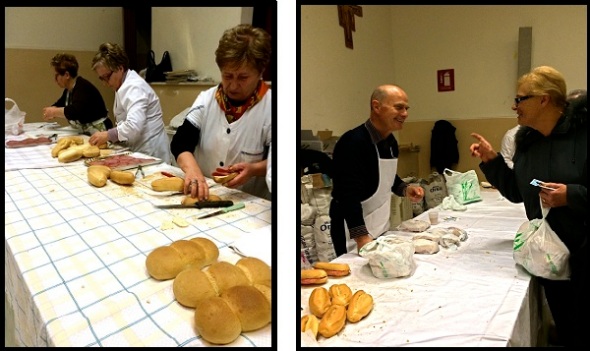You might have understood that being a mama to me means being able to pass down my family and regional traditions. So here you go, this is another Italian tradition my family has never failed to honour: the day of Saint Anthony, which is celebrated on the 17th of January. This guy is considered the father of modern monasticism, the first abbot and also patron saint of domestic animals. This special relation to animals, which is the reason why is super famous in my area, is not directly related to the Christian tradition, but it stems from the XIII century Germany where communities used to provide pigs to their local hospitals where the monks of the order of St. Anthony used to serve. The implementation of pork into these hospitals’ kitchens led to the discovery of the excellent nutritional properties of this meat, which is said to have really carried a Christian medieval Europe into the modern era. For this reason the Saint with the long and white beard started to be associated and represented with a piglet and other domestic animals. This guy is one of my favourite Christian celebrities, maybe because I feel more like a beast, a wild animal too often obliged to respect human’ stupid moral more than that beautiful natural instinct, but I have always kept a small picture of him, like the one below, in my wallet as mean of protection
This patron saint had many devotees especially in the last century when Italy went through one of its most profound economic crisis, the industrial revolution had not started yet and farming represented the only food-assuring kind of trade. The saint’s picture was often put up outside stables’ and barns’ doors to protect animals and on the 17th of January local churches used to bless animals and loaves of bread which were distributed to devotees for them and their livestock. In popular folklore St. Anthony was translated into an old dude with a long beard; he is called vecchiò, a pejorative term that literally means old and robust men. During the evening of the 17th one or more men used to dress up with a long monk’s robe, used to knock on the neighborhood’s doors to scare the household’s kids and ask for a little sausage, a slice of lard, pork chops or anything else that tastes meaty. He was followed by a procession of old and young men that in front of each door sang what we call Pasquella. This song goes like:
Se ce dai na sargiccetta You can give us a sausage,
non importa se piccoletta it does not matter if it is a small one
ma che faccia lo sugo vono but it has to make a good gravy
viva viva Sant’Antonio! long live to Saint Anthony!
Ahh this is incredible; we also had a small musical interlude, amazing. Anyway, after these guys had sang, scared the shit out of the kids and collected enough meat they would have all gone to the nearest cantina – a wine cellar that also serves as a locals’ hangout- to devour all that delicious meat and get absolutely hammered on the wine, as my granddad remembers. Even though during the 50’s in my area started a drastic industrial revolution that has profoundly influenced the lifestyle of Le Marche, our regional and most rural traditions have never really vanished and the cult of St. Anthony is still very popular nowadays. . As I already said this day has always been part of my family weird heritage; first of all because parents have a good reason to tell off their kids and scare them, “if you are not good lo vecchiò will take you away with him”, for fuck’s sake if they’d told me it was all about getting smashed with a bunch of funny chaps at the cantina I would have gone straight away without shedding a tear. Second, it has always been a special day because my granddad allows us to ride into the town and take the horses literally in front of the town church for the blessing of the animals; this has always been my favorite part as I love showing off my equestrian skills in front of people I know; yes i am slightly egocentric so what?! And finally for the ritual of the blessed bread, which my great-grandad Mario Mamao initiated. On the 17th of January, he used to wake up super early to go to the “blessing of the bread” mass and then go to the church oratory to collect enough blessed bread for our animals and for us . But my granddad died almost two years ago and last year for the first time we did not have any blessed bread, there was something missing hence this year my grandmother decided to call all her grand-kids to attend this tradition and go with her to the collection of the blessed bread just before we’d ride away for the horses blessing mass.
This year felt right, it was as it should have been, we had our blessed bread, our little ride through the town and at dinner my grandmother surprised us with another culinary traditional gem: la frittata sbrozzolosa, scrambled eggs with big chunks of sausages that used to be eaten on this day. Bring on Saint Anthony 2015!


